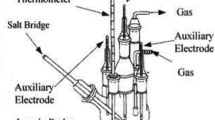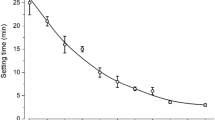Abstract
This study examines the impact of different commercial grout pore solutions and varying concentrations of salts with different cations on the chemical composition of the passive layer and its breakdown process. X-ray photoelectron spectroscopy (XPS), electrochemical impedance spectroscopy (EIS), and potentiodynamic polarization were used to study the passivation and corrosion behaviour of post-tension strands. The strands were passivated for 10 days in ex-situ leached pore solution from pastes made of ordinary portland cement (OPC) and other commercially available grouts, followed by exposure to 0.01 mol of chlorides per day in the form of NaCl, CaCl2, MgCl2, and KCl for the total duration of ten days. The study found that the passivated strands’ Fe 2p3/2 spectra generated from XPS testing included metallic iron (Fe), Fe cementite (Fe3C), a mixture of magnetite and wustite (Fe3O4/FeO), hematite, maghemite, and ferrihydrite (a-Fe2O3/c-Fe2O3/FeOOH), and the satellite structure of Fe2O3/FeOOH. The Nyquist and Bode plots of the EIS spectra showed a higher passivation capability of strands in commercially available grouts compared to OPC. However, potentiodynamic test results revealed that after adding chloride, samples that passivated in OPC pore solution had a higher critical chloride threshold, partially due to a higher pH of the pore solution in this system. The analysis of critical chloride threshold of strands exposed to various salts demonstrated that the cation of chloride salt can significantly affect the passive film breakdown, and the critical chloride threshold of strands changes in the increasing order of MgCl2 < NaCl < CaCl2 < KCl.
Access this chapter
Tax calculation will be finalised at checkout
Purchases are for personal use only
Similar content being viewed by others
References
Hewson, N.R.: Prestressed Concrete Bridges: Design and Construction. Thomas Telford (2003)
Lau, K., Permeh, S., Lasa, I.: Corrosion of prestress and posttension reinforced concrete bridges. In: Corrosion of Steel in Concrete Structures, pp. 81–105. Elsevier (2023)
Minh, H., Mutsuyoshi, H., Niitani, K.: Influence of grouting condition on crack and load-carrying capacity of post-tensioned concrete beam due to chloride-induced corrosion. Constr. Build. Mater. 21(7), 1568–1575 (2007)
Pillai, R., Hueste, M., Gardoni, P., Trejo, D., Reinschmidt, K.: Time-variant service reliability of post-tensioned, segmental, concrete bridges exposed to corrosive environments. Eng. Struct. 32(9), 2596–2605 (2010)
Hamilton, H., Patil, S.R., Torres, E.: Evaluation of Techniques to Remove Defective Grout from Post-Tensioning Tendons (2020)
Hartt, W.H., Venugopalan, S.: Corrosion evaluation of post-tensioned tendons on the Mid Bay Bridge in Destin, Florida (2002)
Powers, R.: Corrosion evaluation of post-tensioned tendons on the niles channel bridge. FDOT, Gainesville, FL (1999)
Lau, K., Lasa, I., Parades, M.: Corrosion development of PT tendons with deficient grout: corrosion failure in ringling causeway bridge. Florida Department of Transportation State Materials Office, Draft Report (2011)
Sprinkel, M.M., Balakumaran, S.S.: Problems with continuous spliced posttensioned–prestressed concrete bulb-tee girder center spans at west point, Virginia. Transp. Res. Rec. 2642(1), 46–54 (2017)
Pessaro, B., Lasa, I.: Corrosion of Post-tensioned Tendons with Deficient Grout. Department of Transportation, Florida (2016)
Glasser, F.P., Marr, J.: Alkali binding potential of OPC and blended cements. Cemento 82(2), 85–94 (1985)
Jawed, I., Skalny, J.: Alkalies in cement: a review: II. Effects of alkalies on hydration and performance of Portland cement. Cem. Concr. Res. 8(1), 37–51 (1978)
Hussain, R., Alhozaimy, A., Al Negheimish, A., Al-Zaid, R., Singh, D.: Mechanism of nucleation and growth of passive film on steel reinforcing bar at different durations of its exposure in concrete pore solution at nanoscale. ACI Mater. J. 112(4), 523 (2015)
Hong, S.-Y., Glasser, F.: Alkali binding in cement pastes: Part I. The CSH phase. Cem. Concr. Res. 29(12), 1893–1903 (1999)
Lothenbach, B., Winnefeld, F.: Thermodynamic modelling of the hydration of Portland cement. Cem. Concr. Res. 36(2), 209–226 (2006)
Moragues, A., Macias, A., Andrade, C.: Equilibria of the chemical composition of the concrete pore solution. Part I: comparative study of synthetic and extracted solutions. Cem. Concr. Res. 17(2), 173–182 (1987)
Vollpracht, A., Lothenbach, B., Snellings, R., Haufe, J.: The pore solution of blended cements: a review. Mater. Struct. 49(8), 3341–3367 (2016)
Teymouri, M., Shakouri, M.: Chloride desorption mechanisms of cement pastes containing fly ash. Constr. Build. Mater. 370, 130667 (2023)
Teymouri, M., Shakouri, M., Vaddey, N.P.: PH-dependent chloride desorption isotherms of Portland cement paste. Constr. Build. Mater. 312, 125415 (2021)
Alonso, M., Garcia, C., Walker, C.: Development of an accurate pH measurement methodology for the pore fluids of low pH cementitious materials. Swedish Nuclear Fuel and Waste Management Co. (2012)
Behnood, A., Van Tittelboom, K., De Belie, N.: Methods for measuring pH in concrete: a review. Constr. Build. Mater. 105, 176–188 (2016)
Ghods, P., Isgor, O., McRae, G., Gu, G.: Electrochemical investigation of chloride-induced depassivation of black steel rebar under simulated service conditions. Corros. Sci. 52(5), 1649–1659 (2010)
Ghods, P., Isgor, O., McRae, G., Miller, T.: The effect of concrete pore solution composition on the quality of passive oxide films on black steel reinforcement. Cement Concr. Compos. 31(1), 2–11 (2009)
Luo, H., Su, H., Dong, C., Li, X.: Passivation and electrochemical behavior of 316L stainless steel in chlorinated simulated concrete pore solution. Appl. Surf. Sci. 400, 38–48 (2017)
Ghods, P., Isgor, O.B., Bensebaa, F., Kingston, D.: Angle-resolved XPS study of carbon steel passivity and chloride-induced depassivation in simulated concrete pore solution. Corros. Sci. 58, 159–167 (2012)
Ming, J., Zhou, X., Zuo, H., Jiang, L., Zou, Y., Shi, J.: Effects of stray current and silicate ions on electrochemical behavior of a high-strength prestressing steel in simulated concrete pore solutions. Corros. Sci. 197, 110083 (2022)
Criado, M., Provis, J.L.: Alkali activated slag mortars provide high resistance to chloride-induced corrosion of steel. Front. Mater. 5, 34 (2018)
Das, J.K., Pradhan, B.: Effect of cation type of chloride salts on corrosion behaviour of steel in concrete powder electrolyte solution in the presence of corrosion inhibitors. Constr. Build. Mater. 208, 175–191 (2019)
Prosek, T., Thierry, D., Taxén, C., Maixner, J.: Effect of cations on corrosion of zinc and carbon steel covered with chloride deposits under atmospheric conditions. Corros. Sci. 49(6), 2676–2693 (2007)
Author information
Authors and Affiliations
Corresponding author
Editor information
Editors and Affiliations
Rights and permissions
Copyright information
© 2024 The Author(s), under exclusive license to Springer Nature Switzerland AG
About this paper
Cite this paper
Shakouri, M., Abraham, O.F., Vaddey, N.P. (2024). Assessing Passivation and Corrosion of Post-tensioning Strand in Grouts Under Chloride Salt Exposure. In: Banthia, N., Soleimani-Dashtaki, S., Mindess, S. (eds) Smart & Sustainable Infrastructure: Building a Greener Tomorrow. ISSSI 2023. RILEM Bookseries, vol 48. Springer, Cham. https://doi.org/10.1007/978-3-031-53389-1_83
Download citation
DOI: https://doi.org/10.1007/978-3-031-53389-1_83
Published:
Publisher Name: Springer, Cham
Print ISBN: 978-3-031-53388-4
Online ISBN: 978-3-031-53389-1
eBook Packages: EngineeringEngineering (R0)




